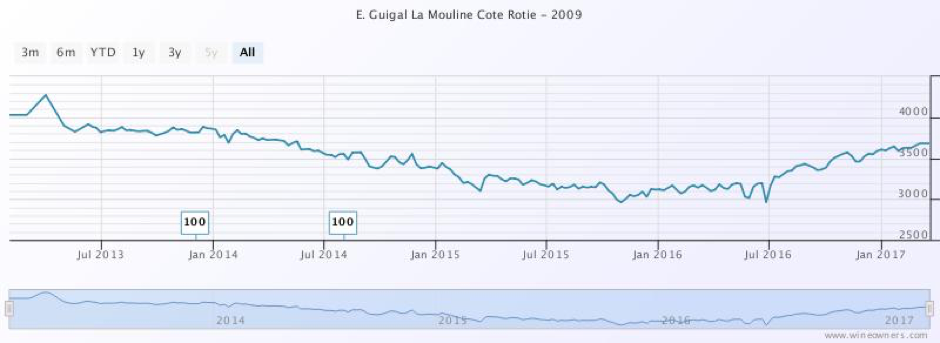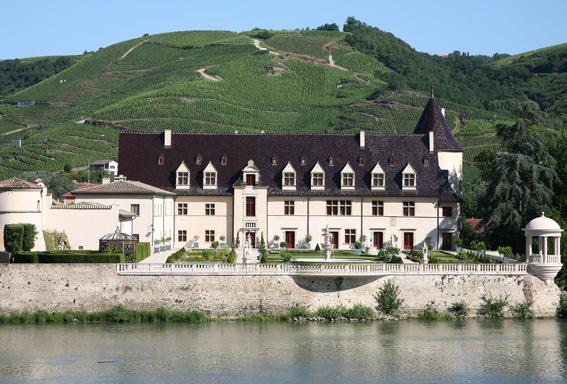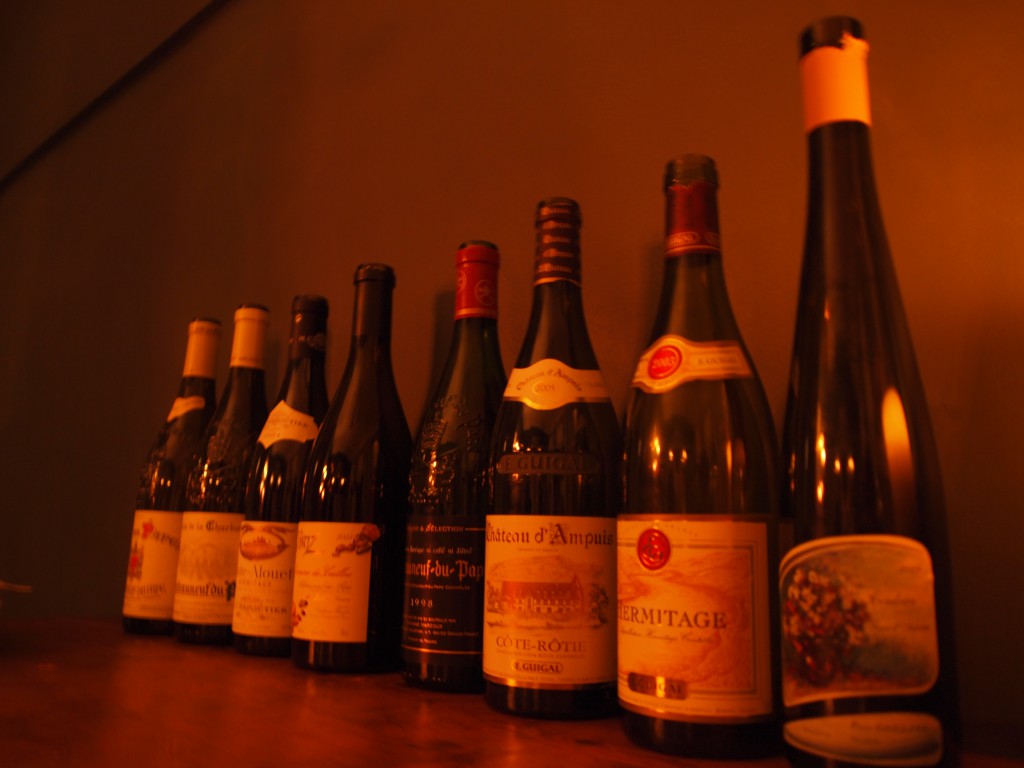by Wine Owners
Posted on 2017-03-22
Few producers ever achieve the magical 100 point rating from the Wine Advocate. Parker’s ratings have been the most influential in the world, so to achieve the magic century is quite some accolade; to achieve it more than once is the stuff of dreams; to achieve it 28 times as have Guigal’s famed Cote Rotie triumvirate of La Landonne, La Turque and La Mouline (collectively nicknamed ‘the La Las’) is unprecedented. No other producer from a single appellation comes close.
You might have thought that these three wine with a claim to be among the finest in the world should cost the earth, shouldn’t they? Well, in fact they don’t – at least not in comparison with the finest wines of Bordeaux, Burgundy and California.
For the purposes of this analysis we’re going to look at the 2009 vintage, which paints a fairly typical picture for these wines. Historically there is very little variation in the values of the three wines, with prices often within a 3% range. So, this chart for La Mouline ’09 is mirrored closely by the other two. What is immediately noticeable is that prices have, until midway through last year, fallen consistently. This despite two 100 point scores in November 2013 and September 2014!

The fall in price is on a par with the falls in value of Bordeaux wines in the same period, but importantly the La Las did not have a huge price rise immediately prior to the falls that insulated many buyers from the slump. It seems, on the face of it that Guigal’s amazing wines were simply the victim of a lack of global interest in Rhone wines at the top end.
This seems to be changing however, as over the last 6 to 9 months the relatively attractive pricing has found favour, and sentiment seems to have turned positive. All good vintages across all three wines are moving upwards, and demand is out-stripping supply for the first time in many years.
La Mouline 09 is 15% up since July, and is on its way back to the £4000 a case level last seen in early 2013. In our view there is reason* to be confident that this recovery is a fundamental re-evaluation of the value of the wine, rather than simply the beneficial effect of weak Sterling, and there is definitely reason* to add this to a cellar, for both investment and drinking purposes.
So, what is this reason you may well ask?
Sadly, the La La’s were among the chosen wines of various boiler room, sales led operations who decided that they were ideal wines to sell as investments to unsuspecting investors at way over fair market prices. This created skewed pricing and led to reputational damage to the wines that caused prices to drop. Thankfully most of these operations have now closed down, and their negative impact on the market has dissipated. The secondary market is now a healthier place for these great wines, and prices are once again reflecting the supreme quality and longevity of Rhone’s finest.

by Wine Owners
Posted on 2016-09-20
There is a central theme within psychology that is concerned with the extent to which behaviour is a product of either inherited (i.e. genetic) or acquired (i.e. learned) characteristics. It seeks to explain how much of a person’s character, personality and behaviour can be attributed purely to evolutionary biology, and how important environmental factors such as education, parenting styles, social status and geographical location are in defining an individual.
There are those who come under the term nativists who believe that genetic characteristics are pre-eminent, and that to a large extent there is genetic ‘pre-wiring’ that is the foundation of all behaviour. On the other hand, there is school of thought labelled behaviourism that suggests humans are a ‘blank slate’ upon which anything can be written.
Anyway, enough of the psychobabble. What has this got to do with wine? The analogy will I am sure be obvious to many of you. All you need do is replace ‘nature’ with ‘terroir’, and ‘nurture’ with ‘winemaker’.
In the 80s and 90s there was a well-documented move towards the winemaker being paramount, particularly prevalent in the New World. This ‘Cult of the Winemaker’ phenomenon, exemplified by such luminaries as Michel Rolland meant that certain styles of wine could be created via specific cellar techniques, which lessened the importance of the raw ingredients and ‘terroir’. This move also coincided with the rise of the superstar wine critics such as Robert Parker whose commentaries not only reflected their tastes and inclinations, but also helped shape the style of wines being made. Even if the effects of ‘Parkerization’ are debatable, the mere fact that the word itself exists suggests an impact of sorts. If nurture, in the guise of the Winemaker and the Critic, were the focus of the final decades of the previous decade, it seems that nature has been making a comeback in this millennium.
Biodynamic techniques, natural wines, and a pointed re-focussing on allowing the land to speak for itself seem to have come back into vogue. Arguably, it is the improvements in cellar technology and techniques introduced by modern Winemakers that have allowed producers to once again champion the primacy of their soil and vines in characterising their wines. Certainly there is a very real sense that individuality is the current keyword for winemakers, and that the best wines being made today have nature rather than nurture as their heartbeat.
The very best wines have always been the expression of their terroir, and it is this link to the land that had made generation after generation fall in love with particular wines. The fact that a vineyard a few hundred yards up the slope from another, or just along the road from another, can produce a wine that is distinct and unique from its neighbour is one of the most fascinating aspects of wine making, and the root of much that intrigues us. Increasingly it is the role of the winemaker to allow this land to express itself eloquently with minimal intervention. The true mark of a great winemaker is now seen as how they can allow the terroir to shine through, rather than how distinctive their ‘signature’ wine making style is.
In recent years there has been a growing consensus within the world of academic psychology that we are now in a post Nature v Nurture world – that no further intellectual currency can be gained by debating a polarised topic when the answer is clearly an amalgam of the two. The interaction and ‘feedback loops’ between the two positions mean that it is a fool’s errand to work out which is more important when it comes to explaining behaviour, and in the world of wine I suspect the same story will play out.
Great wines need both great raw products and great winemakers to help them realise their full potential. To suggest that great wines can be made from average grapes is clearly illogical. Equally, it is unreasonable to think that average winemakers can turn an incredible crop into incredible wines.
History suggests that there are certain plots of land where alchemy can happen. It also shows that there are certain people who can, through talent, hard work and a drop of genius make the products of this land into elixirs. You cannot speak of Montrachet, Hermitage and Cote Rotie without mention of Leflaive, Chave and Guigal.
We do feel in our bones that as wine is the product of an agricultural process, one should accept that what goes on in the field is the number one priority for any producer. But you’d better have a great cellar and great people in it if you want to make magic…
by Wine Owners
Posted on 2014-07-01
Wine Owners celebrated the start of the summer with a Rhone dinner for collectors and enthusiasts at our favourite Farringdon local the Quality Chop House. With everyone bringing an interesting bottle along, this was a great chance to explore the region through the work of some great producers. Particularly exciting was the inclusion of so many white wines from the region, which are often overshadowed by the reds.
Many thanks to all who came and brought wines for the night, and a big thank you to the staff at QCS for looking after us so well!
The wines…
Domaine de la Charbonniere Chateauneuf du Pape Blanc 2011
Fresh and mineral in style with lively acidity and notes of ripe lemon and fresh tarragon with red apple and fig tree. Very nice, but very much a lighter style of Chateauneuf.
Clos des Papes Chateauneuf du Pape Blanc 2012
Clos des Papes was much more typical of the region, with a classic marsanne nose of peach and apricot, with overlaid savoury notes of sourdough bread and a leavening hint of anise
M. Chapoutier Hermitage “Chante Allouette” 2004
A good bottle of this, now fully mature with a characteristic deep gold colour and a nose of honey and heavy floral notes with hints of smoke and toasted nuts.
Domaine de Marcoux Chateauneuf du Pape 1998
Fully resolved now, and exhibiting quite animale character. Not a huge amount of fruit left here, and reminiscent primarily of earth and soft leather. Most agreed this bottle was very slightly corked.
Clos du Caillou Chateauneuf du Pape ‘Les Quartz’ 2003
Very nicely layered dark cherry fruit with hints of licorice and leather. Fresh acidity and very ripe tannins, lovely at the beginning of its drinking window, the previous wine being perhaps at the end
E. Guigal Cote Rotie Chateau d’Ampuis 2005
Powerful and structured, seemed initially slightly closed after an hour plus of decanting, but opened up in the glass to reveal considerable depth – game, herbal notes and bacon fat were all picked out as references, beneath thick layers of dark fruit.
E. Guigal Hermitage 2003
Displaying more lifted red fruit character than the Cote Rotie, Hermitage was nevertheless by any standards rich and opulent, with an admirable freshness and floral character. Opinion divided on preference between this pair!
Pierre Gaillard “Fleurs d'Automne” Condrieu Vendange Tardive 2009
Big flavours of ripe peach and apricot, mixed with tropical fruit, but backed with refreshingly high acidity that prevents this wine from seeming overly and cloying.
>> CLICK HERE TO SEE OUR ALBUM "A TASTE OF RHONE"


